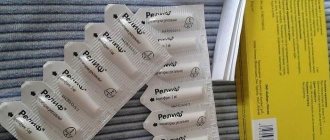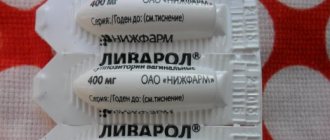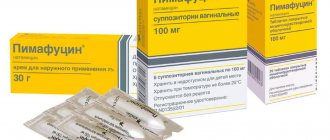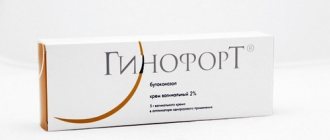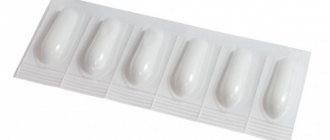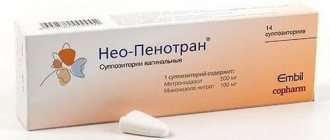Pharmacological action of Clotrimazole
In accordance with the instructions for Clotrimazole, the active ingredient of the medication is clotrimazole.
The drug in all forms of release belongs to the group of imidazole antifungal drugs with a broad spectrum of action.
Clotrimazole ointment, solution, cream and tablets have an antimycotic effect, which is caused by a disruption in the synthesis of ergosterol, which is part of the cell membrane and promotes cell lysis.
In small concentrations, Clotrimazole has a fungistatic effect, in large concentrations it has a fungicidal effect, which promotes its interaction with peroxidase and mitochondrial enzymes. The result of this interaction is an increase in the concentration of hydrogen peroxide to the required toxic level, which contributes to the destruction of the structure of fungal cells.
The instructions for Clotrimazole indicate that the medicine is active against mold and yeast-like fungi, dermatophytes, erythrasma pathogens and lichen versicolor. Clotrimazole in all forms of release has an antimicrobial effect against gram-positive and gram-negative bacteria, and also promotes the destruction of vaginal Trichomonas cells.
There is a high permeability of Clotrimazole into various layers of the skin, where the drug reaches the required therapeutic concentration. When using Clotrimazole vaginal tablets, there is a slight absorption of the drug into the blood.
Terms of sale and storage
Over the counter.
Protect from moisture and light. Storage temperature should not exceed 25°C. Freezing of cream, gel, ointment or solution is not allowed.
You can purchase the drug at any pharmacy. A prescription is not required to purchase the product. It is recommended to store medications at a temperature of 15-25 degrees Celsius. The place should be dry, protected from children and light. The medicine can be used for 3 years from the date of its manufacture.
The cream is available in pharmacies with a prescription, other forms are available without it. Storage conditions: dry, clean place out of reach of children. Shelf life: cream, suppositories and tablets – 3 years, ointment – 2 years.
Indications for use of Clotrimazole
Clotrimazole is prescribed for the treatment of fungal diseases of the mucous membranes and skin, for mycoses of the feet and skin folds, as well as for:
- Erythrasma;
- Athlete's foot;
- Dermatomycosis;
- Candidiasis;
- Genital infections, trichomoniasis, vulvovaginal candidiasis;
- Superficial candidiasis, which is caused by fungi of various species that are sensitive to clotrimazole;
- Stomatitis;
- Dermatophytosis;
- Mycoses accompanied by secondary pyoderma;
- Microsporia;
- Pityriasis versicolor.
Clotrimazole vaginal suppositories are effectively used to sanitize the birth canal immediately before childbirth and as a preventive measure against infection before genital surgery.
When is it used?
Clotrimazole is a drug that acts against various fungi, including the genus Candida. The drug is available in various forms:
- pills;
- cream or ointment;
- candles.
As a rule, it is used for genital forms of lesions. For this purpose, both tablets and cream are excellent for treatment. However, this medicine eliminates discomfort not only with genital thrush. Clotrimazole is also effective for external lesions, for example, nail fungus, as well as diseases of the skin, feet, and groin area. Candidiasis can also be localized on the mucous membranes, for example, in the nose, mouth, and nasopharynx. In this case, Clotrimazole is also used, which is no less effective in this area.
Clotrimazole cream or ointment is well suited for lesions of the skin, folds, lichen, and mycoses. At the same time, not only yeast fungi are sensitive to the drug, but also other species of this class of parasites, for example, dermatophytes or molds. Clotrimazole can also affect other microorganisms that are sensitive to this substance. These include:
- streptococci;
- staphylococci;
- Trichomonas;
- causative agents of tinea versicolor.
There are two more forms of Clotrimazole, which are used mainly for the treatment of the genital area and intestines:
- vaginal tablets or suppositories;
- ointment (cream).
Directions for use and dosage
Clotrimazole vaginal tablets should be administered 1 piece per day as deep as possible into the vagina, preferably in the evening. Clotrimazole suppositories should be administered using a special applicator, which is included with the drug, while lying on your back. Duration of therapy – 6 days. If necessary, the attending physician may prescribe a second course of therapy.
In the treatment of candidal vulvitis and candidal balanitis, it is recommended to simultaneously use suppositories with Clotrimazole cream, which should be applied to the affected areas several times a day for 2 weeks.
When treating trichomoniasis, the combined use of Clotrimazole vaginal tablets with the internal use of chemotherapeutic drugs (for example, metronidazole) is prescribed.
Clotrimazole ointment should be applied to clean affected areas several times a day in a thin layer, gently rubbing into the skin. The duration of therapy depends on the severity and location of the disease. Clotrimazole ointment for the treatment of dermatomycosis must be used for 1 month, pityriasis versicolor - 3-4 weeks, fungal diseases of the skin of the legs - until the symptoms disappear completely. For the treatment of these diseases, you can also use a solution for external use and Clotrimazole cream.
It is not recommended to apply sealed bandages to areas where Clotrimazole cream and ointment are applied.
Specifics of the drug
This product is available in different forms, each of which differs from the others in the method of application and composition. The active substance of the drug is clotrimazole, and it is also supplemented by auxiliary components. All these remedies are not suitable for internal use; they are used only externally or for local treatment.
Main types of the drug:
Candles. The active ingredient in this case is the basis of the product - it contains 100 mg. The composition also contains glycerides, thanks to which the desired consistency is achieved.- Gel. The amount of active substance in it is 10 mg per gram of gel. In addition to it, the composition includes: glycerol, ethyl alcohol, propylene glycol, etc.
- Cream. The content of clotrimazole in it is similar to that in the previous case. It is supplemented with: water, sorbitan stearate, benzyl alcohol, etc.
- Ointment. It also contains 10 mg of active ingredient, and also contains nipagin, propylene glycol, etc.
- Solution. The dry matter of the solution contains 10 mg of clotrimazole. Additional components: ethanol, polyethylene glycol, propylene glycol.
- Intravaginal tablets. The content of clotrimazole in them can be different (100, 200 and 500 mg). Among the auxiliary components are lactose, potato starch, sodium bicarbonate, etc.
In order not to harm your health when using Clotrimazole, you need to know not only its description, but also the indications for use of the drug. It has quite a number of limitations, so patients should be careful. The use of Clotrimazole is permissible in the following situations:
- fungal skin infections;
- nail fungus;
- infectious diseases;
- candidiasis (treatment and prevention);
- fungal diseases of the female genital organs.
Important! It should be said that even if there are indications for the use of the drug, it is better to consult with a specialist regarding the advisability of such actions. Due to contraindications, treatment with its help will not only be ineffective, but also harmful.
When planning to use a drug such as Clotrimazole, you need to take into account the existing contraindications. The main ones:
- allergy to components;
- vaginal bleeding;
- elevated temperature;
- the appearance of discharge with an unpleasant odor;
- gastrointestinal disorders.
These features or their occurrence during treatment require you to stop using this medicine.
Side effects of Clotrimazole
When applied externally, Clotrimazole solution, ointment and cream may cause swelling, peeling, itching and skin irritation.
Clotrimazole cream and ointment may cause erythematous rashes, blisters, paresthesia or urticaria.
When using Clotrimazole suppositories, swelling, burning and itching of the mucous membrane may occur. Individually, when using tablets, vaginal discharge, increased urination, intercurrent cystitis, pain during sexual intercourse, and a burning sensation in the partner’s penis may be observed.
Clotrimazole suppositories: during pregnancy and during menstruation
One of the reasons for the development of thrush is a weakened immune system. The body cannot independently suppress the development of opportunistic microflora and fight pathogenic microflora. During pregnancy, the immune system weakens for obvious reasons - changing hormonal levels adapt the woman’s body to the development of the fetus. After all, the embryo in the early stages is perceived as a foreign agent and can be rejected.
Against this background, the expectant mother faces the risk of developing various ailments provoked by opportunistic microflora in particular. Thrush is one of these.
It is important to consider 3 rules:
- Clotrimazole suppositories during pregnancy are strictly prohibited in the first trimester. In the early stages, there is a risk of active (toxic) substances passing through the placenta to the fetus, as a result of which the drug can cause developmental disorders.
- In the second and third trimester, antifungal suppositories, if necessary, are prescribed to patients at reduced dosages. This takes into account the expected benefits of using Clotrimazole and the expected harm that can be caused to the baby in the womb.
- The same applies to the period of breastfeeding. The active substance, although in low concentration, enters the bloodstream. There is no exact data on how it affects the quality of breast milk and whether it can cause reactions in an infant. Therefore, the justification of treatment during this period should only be determined by a doctor.
Moreover, Clotrimazole suppositories cannot be used during menstruation. Firstly, the effectiveness of such treatment will be reduced to almost zero. And secondly, the mucous membrane is very susceptible during this period, since the old layer is peeled off, and the young one is very thin. Penetration of the active substance into the blood increases significantly. Knowing about its toxicity, one can only guess what the consequences may be.
The effectiveness of Clotrimazole in the fight against thrush
Clotrimazole ointment is a universal drug for external use, which is often used to treat thrush in women, men and even children.
Despite the simplicity of the composition, the product is quite effective not only in the treatment of thrush, but also in the treatment of other diseases caused by pathogenic microorganisms, such as staphylococcus, streptococcus.
The ointment allows you to get rid of negative symptoms, such as:
white coating on the vaginal mucous membranes,
- itching,
- swelling,
- hyperemia,
- pain and discomfort.
Despite the fact that the drug allows you to completely cure thrush, you should not expect a quick effect from the therapy. By combining different forms of Clotrimazole, complete recovery can be accelerated.
The effectiveness of the drug is caused by ergosterol, a substance included in the ointment. It is this component that leads to the elimination of pathogenic fungi due to the fact that it promotes the loss of nutrients and leads to paralysis of the vital activity of bacteria. The effect of the drug extends to such types of mushrooms that reproduce by division.
By taking the drug in a minimal dosage or not regularly, the patient deprives himself of the opportunity to be cured, thereby simply blocking the spread of fungi. Absolute recovery can only be achieved with complex treatment, following the dosage and doctor’s recommendations.
Analogues of Clotrimazole in the treatment of thrush
Since some patients may be contraindicated for treatment of thrush with Clotrimazole, the attending physician may replace the drug with an analogue in which the main active ingredient will be completely different.
Thus, drugs that do not contain clotrimazole are the following analogues:
| Name of analogue | Active substance | Release form | Cost, rub. |
| Bifosin | Bifonazole | Cream, powder, spray, solution | 30-120 |
| Mikogal | Omoconazole | Cream, suppositories, vaginal tablets | 400-900 |
| Pimafucin | Natamycin | Candles and tablets, cream | 350-510 |
| Nystatin | Nystatin | Ointment, suppositories, tablets | 65-90 |
Despite the similar effect, you should not independently replace Clotrimazole with its analogues. Each of the above analogues has its own side effects, which can worsen the patient’s condition.
Features of use
Treatment of sexually transmitted infections must be carried out in both partners. Combined use with Dexamethasone reduces the effectiveness of Clotrimazole.
Vaginal administration of the drug reduces the therapeutic effect of polyene antibacterial agents, in particular: nystatin, amphotericin B and nitamycin.
If Clotrimazole is used together with alcohol, it can cause the development of intoxication and its negative manifestations.
Alcohol consumption significantly reduces the antifungal effect of the antifungal agent.
For the treatment of trichomoniasis, systemic oral medications (metronidazole) are prescribed together with Clotrimazole.
Nystatin is a polyene antibiotic that belongs to the category of antifungal drugs. Its activity is manifested against yeast cultures of the Candida family and Aspergillus. It is these strains that are responsible for the formation of candidal lesions that can appear on the surface of the skin and mucous membranes.
The most striking representative of such diseases is thrush, which is characterized by fairly pronounced symptoms and can cause many problems to its owner. Both men and women are equally susceptible to its development. Moreover, for the weaker half of humanity it can have much more serious consequences, which include the formation of cervical erosion.
Treatment of candidiasis is complex and is based on the use of several equivalent areas. One of them is medications that help suppress the fungal environment. Moreover, without raising the immune characteristics of the body, their use will not bring the desired result and the disease will appear again, even after its complete neutralization.
The main purpose of Nystatin is the treatment of candidal diseases or prevention after the use of antibiotics, especially the penicillin group. Today it is available in several dosage forms and is used to suppress the activity of yeast in the mouth, on the surface of the skin, and the walls of the vagina or intestines.
As a rule, suppositories are used to eliminate vaginal forms of the disease; neutralization of external manifestations of infection is carried out by local application, and more complex cases require complex treatment and oral administration of the drug. Nystatin is one of those rare drugs that, when entering the body, have virtually no effect on it no effect, passing through the gastrointestinal tract.
As a result of this, it is not absorbed into the blood at all, does not interact with other drugs, does not penetrate mucous membranes and is absolutely not amenable to biological transformation. The drug is excreted from the body naturally in unchanged form with feces.
Nystatin suppositories, tablets and ointments have a destructive effect on the membranes of fungal cells, as a result of which they become deformed and die. At the same time, neighboring tissues remain unchanged and continue to function fully.
Nystatin and alcohol, when used together, do not have any negative effect on the body, except in cases of ethanol intolerance, which provokes the development of side symptoms. It occurs quite rarely and is associated with hypersensitivity to individual components of the drug. It looks like this:
- nausea;
- vomit;
- headache;
- stool disorder;
- stomach ache;
- temperature increase;
- chills;
- development of allergic reactions.
Such symptoms almost completely coincide with the list of possible side effects of the drug. At the same time, its combination with alcohol-containing drinks increases the intensity of their manifestations and contributes to the development of complications, which lead to exacerbation of concomitant diseases and contribute to the development of relapse phenomena.
Additional information about the drug "Clotrimazole" (suppositories)
The instructions warn that during the prenatal period, administration is carried out without an applicator. To cleanse the birth canal, it is recommended to use one suppository once. Since vaginal suppositories are in the form of tablets, accidental ingestion of the medicine is possible. When taken orally, the drug provokes gastrointestinal disorders, nausea, vomiting, abdominal pain, renal disorders, as well as allergic skin reactions. There is no special antidote, so in case of poisoning, the stomach is washed out. It is recommended to drink activated carbon and consult a doctor. It should be noted that the use of the drug “Clotrimazole” (suppositories), the instructions confirm this information, should be continued for the entire period prescribed by the doctor, even if the symptoms of the pathology disappear before the end of the therapy period.
Experts' opinion
Considering the considerable duration of the course of treatment for fungal infections, it is not surprising that many people have questions about the possibility of drinking alcohol. In this regard, experts provide the following recommendations:
- simultaneous use is strictly prohibited;
- there is no specific permissible dose of alcohol; drinking it in any case will not have the best effect on the body;
- periodic consumption of alcoholic beverages during therapy is also undesirable;
- men can take the medicine 8-9 hours before and 6 after drinking;
- for women - 12-13 hours before and 9-10 after drinking alcohol.
Complete elimination of the drug substance occurs only after 24 hours, so in general it is better to avoid drinking during this time to avoid negative consequences.
The use of Clotrimazole suppositories changes the situation a little. Since they are not absorbed into the blood, the drug is not eliminated through the liver. Accordingly, due to their local action, they do not interact with ethanol.
If side effects occur due to combining alcohol with a drug, you should take the following actions:
- stop drinking alcoholic beverages;
- drink plenty of water within 4 hours;
- carefully study the instructions for the drug;
- seek advice and help from doctors.
Also, if negative reactions occur once, you should abstain from alcoholic beverages for the entire period of treatment and for another month after the end of therapy.
Fungal infections are an unpleasant disease that requires drug treatment, sometimes quite lengthy.
The drug Clotrimazole has proven itself well in the treatment of such diseases. Due to the duration of treatment, it is necessary to find out in advance how the combination of Clotrimazole and alcohol works.

